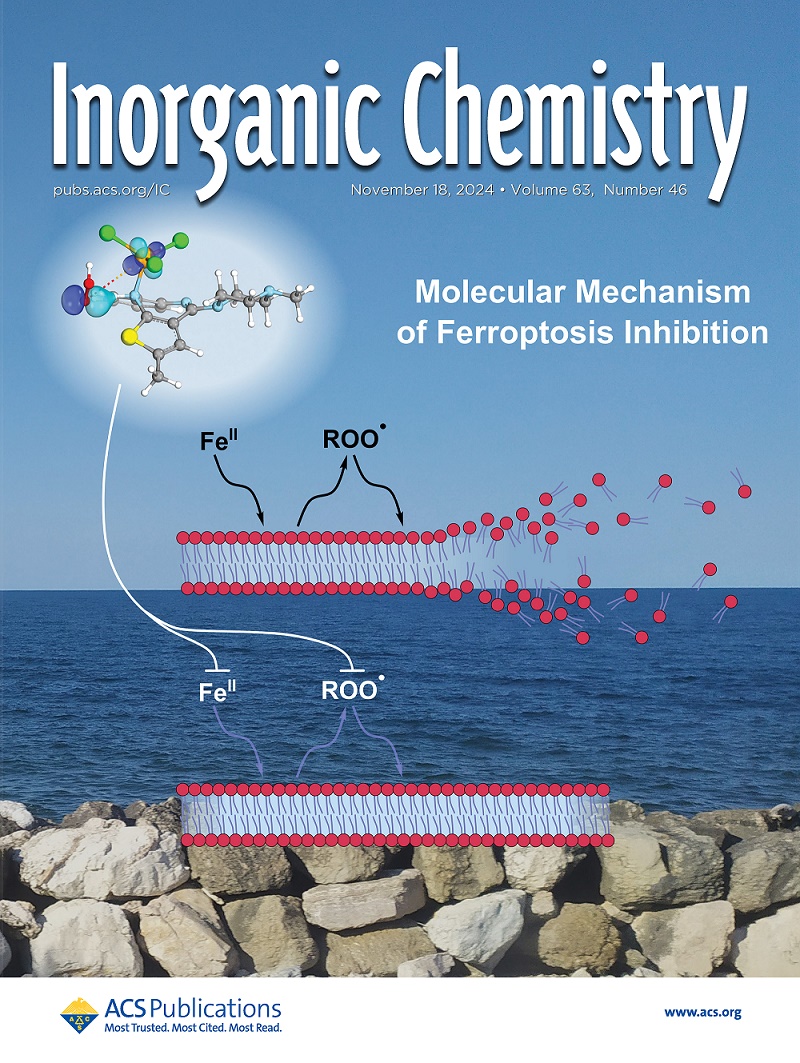基于Cp*M/N (M = Rh, Ir)对的受挫Lewis对活化CO、异氰酸酯和炔
IF 4.3
2区 化学
Q1 CHEMISTRY, INORGANIC & NUCLEAR
引用次数: 0
摘要
复合物(Cp * M(κ3 N, N ', N - l)] [SbF6] (Cp * =η5-C5Me5;M = Rh, 1, Ir, 2;HL = pyridinyl-amidine)对一系列含有三键的底物表现出M/N过渡金属受挫刘易斯对反应性。铑配合物1与CO反应生成的化合物[Cp*Rh(CO)(κ2C,N-LCO)][SbF6](3)含有末端羰基和氨基,而铱配合物2生成的化合物[Cp*Ir(κ3C,N,N'-LCO)][SbF6](4)只含有氨基。化合物1和2与异氰酸酯CNR (R = Cyclohexyl, p-C6H4(OMe), CH2SO2(p- toyl))反应生成相应的1,1-插入配合物[Cp*M(κ3C,N,N'-LCNR)][SbF6](5-10)。用过量的异氰化物处理1和2,得到含有插入式[Cp*M(CNR)(κ2C,N-LCNR)][SbF6](11-15)的配位异氰化物配合物。化合物2与CNtBu反应生成含有末端CNtBu配体的加合物[Cp*Ir(CNtBu)(κ2N,N'-L)][SbF6](16)。配合物16被HSbF6质子化生成[Cp*Ir(CNtBu)(κ2N,N'-HL)][SbF6]2(17)。末端炔HC≡CR (R = Ph, CO2Et)与1和2反应生成炔基配合物18-21。二甲基乙炔二羧酸酯与配合物2通过一个碱性氮原子和横跨炔三键的金属的1,2加成反应生成化合物22。用分析、光谱和x射线衍射(XRD)等方法对新配合物进行了表征。本文章由计算机程序翻译,如有差异,请以英文原文为准。
Activation of CO, Isocyanides, and Alkynes by Frustrated Lewis Pairs Based on Cp*M/N (M = Rh, Ir) Couples.
The complexes [Cp*M(κ3N,N',N″-L)][SbF6] (Cp* = η5-C5Me5; M = Rh, 1, Ir, 2; HL = pyridinyl-amidine) display M/N transition metal frustrated Lewis pair reactivity toward a range of substrates containing triple bonds. Whereas the rhodium complex 1 reacts with CO yielding compound [Cp*Rh(CO)(κ2C,N-LCO)][SbF6] (3), which contains a terminal carbonyl and a carbamoyl group, the iridium complex 2 generates compound [Cp*Ir(κ3C,N,N'-LCO)][SbF6] (4), which only features the carbamoyl group. Compounds 1 and 2 react with stoichiometric amounts of the isocyanides CNR (R = Cyclohexyl, p-C6H4(OMe), CH2SO2(p-Tolyl)) to give the corresponding 1,1-insertion complexes [Cp*M(κ3C,N,N'-LCNR)][SbF6] (5-10). Complexes containing inserted and coordinated isocyanide ligands of formula [Cp*M(CNR)(κ2C,N-LCNR)][SbF6] (11-15) are obtained upon treating 1 and 2 with excess of the corresponding isocyanide. Compound 2 reacts with CNtBu affording the adduct [Cp*Ir(CNtBu)(κ2N,N'-L)][SbF6] (16) which contains a terminal CNtBu ligand. Complex 16 is protonated by HSbF6 to give [Cp*Ir(CNtBu)(κ2N,N'-HL)][SbF6]2 (17). The terminal alkynes HC≡CR (R = Ph, CO2Et) react with 1 and 2 rendering the alkynyl complexes 18-21. Dimethyl acetylenedicarboxylate reacts with complex 2 to give compound 22 via the formal 1,2-addition of a basic nitrogen atom and the metal across the alkyne triple bond. The new complexes have been characterized by analytical, spectroscopic and X-ray diffraction (XRD) methods.
求助全文
通过发布文献求助,成功后即可免费获取论文全文。
去求助
来源期刊

Inorganic Chemistry
化学-无机化学与核化学
CiteScore
7.60
自引率
13.00%
发文量
1960
审稿时长
1.9 months
期刊介绍:
Inorganic Chemistry publishes fundamental studies in all phases of inorganic chemistry. Coverage includes experimental and theoretical reports on quantitative studies of structure and thermodynamics, kinetics, mechanisms of inorganic reactions, bioinorganic chemistry, and relevant aspects of organometallic chemistry, solid-state phenomena, and chemical bonding theory. Emphasis is placed on the synthesis, structure, thermodynamics, reactivity, spectroscopy, and bonding properties of significant new and known compounds.
 求助内容:
求助内容: 应助结果提醒方式:
应助结果提醒方式:


